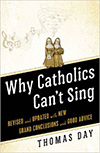

|
| Musical Musings: Product-related |
|
|
Why Catholics Can't Sing … AgainThe original, shocking volume dates from 1991. On the cover, the author, Thomas Day is accused of being a "misguided troublemaker," but he is also a CPA award winning author, and chairman of the music department at Salve Regina College in Newport, Rhode Island. This brief article outlines the Second Edition (2013).
Why are the songs many Catholics are asked to sing in church the worst music they will hear all week?
What bad ideas and habits goad talented musicians to inflict on praying adults such sappy tunes that even young children groan?
How did the Church that gave us chant, Palestrina, Mozart, and some great old hymns turn into the temple of schmaltz?
Why do many Catholics sit in their pews in silence and wait for the cantor to stop?
Do not be misled by the title. The original book had a subtitle: "The Culture of Catholicism and the Triumph of Bad Taste." That's actually more what the book is about than merely pew-sitters who can't (or don't) sing. The whole misguided clerical culture of music in the decades after Vatican II — what prompted it, what sustained it, and what eventually will dismantle it. That is what the book is about! If you read the first edition, you know that Thomas Day is a humorous yet insightful writer. He hits the nail on the head, but explains why so many people are trying to use a screwdriver to do just that, instead of the hammer that would be obvious and effective. But if you haven't read the updated and revised edition (2013) you're missing out on two decades of refinement — more than a quarter of the book is brand new material. Just what's new?
Jeffrey Tucker writes in the new Preface: Like most others who read Thomas Day's masterpiece in the 1990s, I went to this book to find answers. My parish music situation was utterly confusing. I knew music history. I loved chant and polyphony. Part of what drew me to Catholicism in the first place was my realization that the Church had created Western music as we know it, inspired by the worship of God. As a person who is very serious about art, I wanted to embrace the faith that saw art as the expression of the hand of God at work in the world. My conversion took place in something of a musical bubble (at the National Shrine in Washington DC). Once I entered the "real world" of parish life, I went into shock. Any practicing Catholic knows what I mean by that. This "shock" is exactly what Day addressed in Why Catholics Can't Sing. The new volume expands considerably on this. "The new insights I acquired after the original edition was published," writes Day, "have been incorporated into the last two chapters of this (new) book, 'Grand Conclusions' and 'Good Advice.'" Writing the revised edition has been a somewhat unpleasant experience for me. I cringed when I reread some paragraphs in the original edition. My words had too frequently created the impression that I wanted everybody to sing vigorously at Mass. The point I was trying to make was that the volume of the congregation's singing, measured in decibels, is not important. What is important is singing that comes across as the assembly's prayer — even if many do not want to join in the singing [Introduction 2013]. The revised edition offered an abundance of practical advice. Some sub-headings from the new last chapters:
If you've never read what Jeffrey Tucker calls "this incredibly wise book," by all means, get yourself a copy. If you read and digested the original, you still stand to profit from the re-thinking, fresh angles and practical advice in the new edition, which "pull together the experiences and insights of a lifetime and attempt to explain (at last!) why there are now happy stories about liturgical music and what we can learn from them."
Article written 06 October 2014 |
Submit Your Music / Contact Us / Company Description / Links
 Twenty-two years later and we have more wisdom, more insight, and … frankly, more book (26% more!).
If you've read the first edition (1991), then you understand the back cover notes from the new book:
Twenty-two years later and we have more wisdom, more insight, and … frankly, more book (26% more!).
If you've read the first edition (1991), then you understand the back cover notes from the new book: